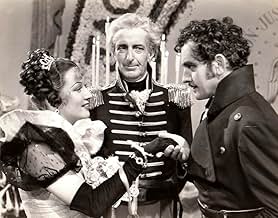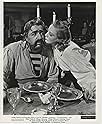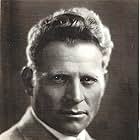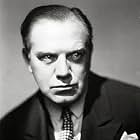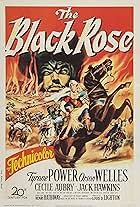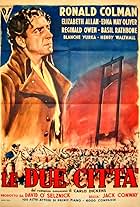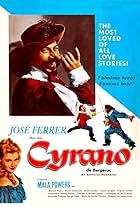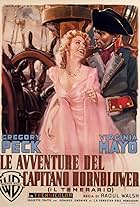VALUTAZIONE IMDb
6,6/10
803
LA TUA VALUTAZIONE
Aggiungi una trama nella tua linguaSemi-fictional account of pirate Jean Lafitte's involvement in the War of 1812.Semi-fictional account of pirate Jean Lafitte's involvement in the War of 1812.Semi-fictional account of pirate Jean Lafitte's involvement in the War of 1812.
- Candidato a 1 Oscar
- 1 candidatura in totale
Fred Kohler
- Gramby
- (as Fred Kohler Sr.)
Trama
Lo sapevi?
- QuizAnthony Quinn, who plays Beluche, directed the remake of this film (I bucanieri (1958)). Douglass Dumbrille, who played Gov. Claiborne in this film, appeared in the 1958 remake, in which he played a prominent New Orleans citizen.
- Colonne sonoreYankee Doodle
(uncredited)
Traditional
Sung by the pirates
Recensione in evidenza
This was the third version I watched of the exploits of French pirate Jean Lafitte, but the first that was made; the others were LAST OF THE BUCCANEERS (1950) and the 1958 remake of the film under review. Interestingly, while De Mille himself produced the latter, he relinquished the directorial reins – presumably because he was too ill for the task – to his son-in-law, actor Anthony Quinn (who had a supporting role in the original!), whose only effort in this capacity it proved to be. For the record, two other cast members were similarly featured in both i.e. Douglass Dumbrille and Jack Pennick.
Anyway, this was also the third in my Fredric March epic viewings (with one more to go): it is telling that the star's tendency towards ham (not helped by his adopting a foreign accent – which did not really come into play when he interpreted an Italian in THE AFFAIRS OF CELLINI or a Russian in WE LIVE AGAIN {both 1934}!) was brought out by the director's idiosyncrasies (including a frequent resort to collective singing – albeit of patriotic American songs rather than the usual salty ditties!) that, evidently, were not restricted to his frequent religious ventures. While fine in itself, then, the movie emerges as perhaps the least of De Mille's 1930s spectacles. Incidentally, it had been planned for a local TV broadcast in the mid-1980s which never materialized!
As expected, the settings, crowd scenes and action highlights are elaborate as can be; the cast list, too, is extensive – peppered with familiar faces and even a few award-winning actors (a delightful Akim Tamiroff as March's sidekick and a grumpy Walter Brennan, who enters late into the proceedings as his counterpart to General and future American President Andrew Jackson). The latter is effectively played by one Hugh Sothern, who reprised the role a year later for the two-reel short OLD HICKORY. On the other hand, the major female presences (one spunky and the other stately) are decorative more than anything else – the former, Hungarian Franciska Gaal (here being groomed for U.S. stardom but which did not happen), is rather overbearing under the circumstances.
The narrative sees privateer Lafitte side with the Americans against the British in the war of 1812; traitorous Senator Ian Keith does his best to make him look bad in the eyes of the people of Louisiana, even having the Navy massacre the pirate band intending to support them!; ultimately, they face-off in a swordfight inside a jail. Eventually, the "boss" reaches an agreement with Jackson, and his contribution (led by former Napoleonic cannoneer Tamiroff's expertise) is vital in repelling the much larger enemy forces. However, when all differences seem to have been settled, an old crime – which a rogue section of Lafitte's men were responsible for but not he personally – resurfaces, so the buccaneer is forced to go into exile, forever roaming the seas
Despite its historical pedigree, the film stands as an example of what used to be branded "enjoyable hokum", of which De Mille was a prime exponent; that said, its professionalism is undisputed and, in fact, Victor Milner's cinematography (which, for one night-time rallying sequence, turns sepia) garnered the movie its sole Oscar nomination. By the way, the "Leslie Halliwell Film Guide" erroneously lists this as having a mere 90-minute duration – when, in fact, the TCM-sourced print I watched (exhibiting some picture instability halfway through which, however, were smoothed over upon being replayed!) lasted a good deal more at 126!!
Anyway, this was also the third in my Fredric March epic viewings (with one more to go): it is telling that the star's tendency towards ham (not helped by his adopting a foreign accent – which did not really come into play when he interpreted an Italian in THE AFFAIRS OF CELLINI or a Russian in WE LIVE AGAIN {both 1934}!) was brought out by the director's idiosyncrasies (including a frequent resort to collective singing – albeit of patriotic American songs rather than the usual salty ditties!) that, evidently, were not restricted to his frequent religious ventures. While fine in itself, then, the movie emerges as perhaps the least of De Mille's 1930s spectacles. Incidentally, it had been planned for a local TV broadcast in the mid-1980s which never materialized!
As expected, the settings, crowd scenes and action highlights are elaborate as can be; the cast list, too, is extensive – peppered with familiar faces and even a few award-winning actors (a delightful Akim Tamiroff as March's sidekick and a grumpy Walter Brennan, who enters late into the proceedings as his counterpart to General and future American President Andrew Jackson). The latter is effectively played by one Hugh Sothern, who reprised the role a year later for the two-reel short OLD HICKORY. On the other hand, the major female presences (one spunky and the other stately) are decorative more than anything else – the former, Hungarian Franciska Gaal (here being groomed for U.S. stardom but which did not happen), is rather overbearing under the circumstances.
The narrative sees privateer Lafitte side with the Americans against the British in the war of 1812; traitorous Senator Ian Keith does his best to make him look bad in the eyes of the people of Louisiana, even having the Navy massacre the pirate band intending to support them!; ultimately, they face-off in a swordfight inside a jail. Eventually, the "boss" reaches an agreement with Jackson, and his contribution (led by former Napoleonic cannoneer Tamiroff's expertise) is vital in repelling the much larger enemy forces. However, when all differences seem to have been settled, an old crime – which a rogue section of Lafitte's men were responsible for but not he personally – resurfaces, so the buccaneer is forced to go into exile, forever roaming the seas
Despite its historical pedigree, the film stands as an example of what used to be branded "enjoyable hokum", of which De Mille was a prime exponent; that said, its professionalism is undisputed and, in fact, Victor Milner's cinematography (which, for one night-time rallying sequence, turns sepia) garnered the movie its sole Oscar nomination. By the way, the "Leslie Halliwell Film Guide" erroneously lists this as having a mere 90-minute duration – when, in fact, the TCM-sourced print I watched (exhibiting some picture instability halfway through which, however, were smoothed over upon being replayed!) lasted a good deal more at 126!!
- Bunuel1976
- 17 mar 2014
- Permalink
I più visti
Accedi per valutare e creare un elenco di titoli salvati per ottenere consigli personalizzati
- How long is The Buccaneer?Powered by Alexa
Dettagli
- Data di uscita
- Paese di origine
- Lingue
- Celebre anche come
- The Buccaneer
- Luoghi delle riprese
- White's Landing, Santa Catalina Island, Channel Islands, California, Stati Uniti(Barataria settlement recreation)
- Azienda produttrice
- Vedi altri crediti dell’azienda su IMDbPro
- Tempo di esecuzione2 ore 6 minuti
- Colore
- Proporzioni
- 1.37 : 1
Contribuisci a questa pagina
Suggerisci una modifica o aggiungi i contenuti mancanti

Divario superiore
By what name was I filibustieri (1938) officially released in India in English?
Rispondi


